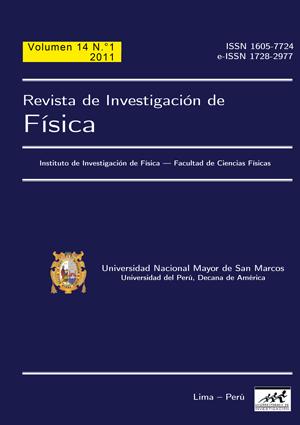Mineralogical characterization of the clay fraction of vertisols from the Universidad Nacional de Piura parcel, San Lorenzo, Piura
DOI:
https://doi.org/10.15381/rif.v14i01.8726Keywords:
Clay fraction, vertisols, clay minerals, X ray fluorescence, transmission Mössbauer spectroscopy, X-ray diffractometry.Abstract
In this paper we study the mineralogical characterization of the clay fraction of two samples of agricultural soils from Vertisols from the Valle de San Lorenzo, Piura Region, using analytical techniques such as energy dispersion X-ray fluorescence (XRF), X-ray difractometry (XRD) and transmission Mössbauer spectroscopy (TMS). Prior to their mineralogical characterization, the samples were subjected to physicochemical analysis such as measuring their pH, removal of organic matter and textural analysis. In this work we have used two samples, which have been referred to as M1 and M2 and drawn two different calicatas at a depth of 50 cm and 150 cm respectively. Mössbauer spectra were taken at room temperature. Analysis of both samples by XRF indicated that both samples have approximately the same concentration of Fe, which was approximately 3,5% and 3,9% for M1 and M2 respectively. It also notes the presence of some elements that serve as plant nutrients as Ca, K, Cu, Zn and Mn, which may be present in clay minerals as interlayer cations. The mineralogical analysis by XRD of both samples show the presence of phases of quartz, albite and clay minerals such as montmorillonite, illite (2:1 type) and kaolinite (1:1 type). The analysis by TMS of both samples showed the presence of Fe3+ paramagnetic cations occupying octahedral sites (cis and trans) in montmorillonite; additionally it is noted the presence of a paramagnetic doublet of Fe3+, which has been associated with tetrahedral sites in montmorillonite for having small isomeric shift and quadrupole splitting. Finally, a Fe2+ doublet has been observed which has not been associated with any specific mineral since its parameters superimpose with those for montmorillonite, illite and kaolinite. These results also indicate that iron is mainly distributed within the octahedral sites of montmorillonite in both samples.Downloads
Published
Issue
Section
License
Copyright (c) 2011 Fabian E. Nima Ramírez, Jorge A. Bravo Cabrejos, Mirian E. Mejia Santillán, Denis Silva Valdiviezo

This work is licensed under a Creative Commons Attribution-NonCommercial-ShareAlike 4.0 International License.
THE AUTHORS RETAIN THEIR RIGHTS:
a. The authors retain their trademark and patent rights, as well as any process or procedure described in the article.
b. The authors retain the right to share, copy, distribute, perform and publicly communicate the article published in the Revista de Investigación de Física (for example, place it in an institutional repository or publish it in a book), with an acknowledgment of its initial publication in the Revista de Investigación de Física.
c. The authors retain the right to make a subsequent publication of their work, to use the article or any part of it (for example: a compilation of their works, notes for conferences, thesis, or for a book), provided that they indicate the source. of publication (authors of the work, journal, volume, number and date).






